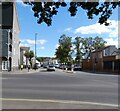1
Cobden Street, Foleshill, Coventry
This view shows Cobden Street looking south towards Red Lane; the block of flats in the distance is in Hillfields.
Cobden Street was laid out in the 1850s as part of a development by the Coventry and Warwickshire Artizans Freehold Land Society. For more on this society see
Image
David Fry & Albert Smith suggest that a sense of the Society's members' political views can be gained from the street names they chose. Cobden refers to Richard Cobden, the radical and Liberal politician who formed the Anti-Corn Law League along with John Bright; the land society also laid out a Bright Street nearby. The League was a free trade movement that campaigned to end the protectionist corn laws, which taxed imported wheat to the benefit of landowners but at the cost of increased bread prices. Cobden & Bright succeeded in abolishing the corn laws in 1846, with belated support from the Tory prime minister Sir Robert Peel, after whom another of the streets is named. Cobden was later responsible for the 1860 Cobden-Chevalier free trade treaty with France, which led to the collapse of the Coventry ribbon weaving industry and the ruin of many local people, but the street name endured. https://en.wikipedia.org/wiki/Richard_Cobden
The development of the estate proceeded slowly, and many of the houses in this photo may date from later in the 19th century or even early 20th century, though the addition of insulating cladding in the 2010s has obscured many of the architectural clues; see the discussion in Fry, D & Smith, A, The Coventry we have lost: Forgotten Foleshill, Simanda Press, Berkswell, pp91-92. The area also suffered heavily from bombing in the second world war.
Image: © A J Paxton
Taken: 26 Aug 2021
0.04 miles
2
Housing on Red Lane
Image: © JThomas
Taken: 4 Mar 2017
0.05 miles
3
Stoney Stanton Road, Coventry
Image: © David Howard
Taken: 21 May 2023
0.05 miles
4
Peel Street, Coventry
From Stoney Stanton Road
Image: © David Howard
Taken: 21 May 2023
0.06 miles
5
Red Lane
Off Stoney Stanton Road.
Image: © Gerald England
Taken: 24 Sep 2021
0.06 miles
6
Terraced houses, Red Lane, Coventry
Built in the late 19th century with single-skin external walls of red brick, these houses have in most cases been given a layer of external cladding for insulation, as part of a programme of energy conservation work undertaken by housing associations around 2013-15.
Image: © A J Paxton
Taken: 14 Jun 2021
0.06 miles
7
Peel Street, Foleshill, Coventry
We are looking west along Peel Street towards Stoney Stanton Road, where a white shikhara or domed tower of the Hindu temple can be seen.
This street was laid out in the 1850s as part of a development by the Coventry and Warwickshire Artizans Freehold Land Society. For more on this society see
Image A sense of its members' political views can be gained from the street names; Peel refers to Sir Robert Peel, the Tory politician who served as prime minister from 1834–1835 and 1841–1846 and who played a central role in the formation of the modern Conservative Party.
The development proceeded slowly, and the houses in this photo have a late 19th or early 20th century appearance; see the discussion in Fry, D & Smith, A, The Coventry we have lost: Forgotten Foleshill, Simanda Press, Berkswell, pp91-92.
Many of the houses in this district now belong to housing associations, and in the 2010s they were given an external insulating cladding to improve their energy efficiency. This can be seen on some of the houses on the right hand side, particularly around the door visible at the right edge of the photo.
Image: © A J Paxton
Taken: 26 Aug 2021
0.07 miles
8
Stoney Stanton Road, Coventry, looking northwards from the canal bridge towards the junction with Red Lane
An older photo than the other one of this title; this one was taken in March 2014. At the corner with Red Lane can just be seen the boarded-up Three Horseshoes pub, which has since become a restaurant. There was a pub of this name here from 1861; much of the building lost its first floor in an air raid in the second world war, leaving the single storey with flat roof that remains. https://www.historiccoventry.co.uk/cph/main/pub.php?pg=three_horse_shoes_stoney_stanton Beyond Red Lane are three and four storey apartments built in the early 21st century on the site of 19th century housing that had fallen into a poor condition. Coventry Peace House occupies the first six houses at the right of the photo, painted yellow with a white dove.
Image: © A J Paxton
Taken: 9 Mar 2014
0.07 miles
9
Stoney Stanton Road, Coventry, looking northwards from the canal bridge towards the junction with Red Lane
To the right, just beyond the bridge, can be seen Ordnance Road; the white-painted house on the corner was a post office for many years. The street is now a quiet cul-de-sac, but in the early 20th century it was the approach to the Coventry Ordnance Works, which made a range of weapons including army howitzers and naval guns. The OS 6 inch series map, 1888-1913, shows a mineral line crossing Stoney Stanton Road, just beyond the white house, connecting the factory and the brickworks opposite to the Coventry-Nuneaton railway. https://maps.nls.uk/geo/explore/side-by-side/#zoom=17&lat=52.41909&lon=-1.49801&layers=6&right=OSAPI The ordnance works closed in 1925. https://en.wikipedia.org/wiki/Coventry_Ordnance_Works The row of 6 yellow-painted houses beyond form Coventry Peace House, a housing co-operative active in peace and solidarity work. https://coventrypeacehouse.wixsite.com/coventry-peace-house
Image: © A J Paxton
Taken: 14 Jun 2021
0.07 miles
10
Stoney Stanton Road
A short terrace of houses on Stoney Stanton Road, by the old Webster's brickworks site and opposite the Red Lane junction.
Image: © E Gammie
Taken: 11 Mar 2009
0.08 miles



















